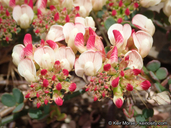Taxon Report
Acmispon cytisoides (Benth.) BrouilletBentham's broom |
 Keir Morse |
Taxon Summary
Acmispon cytisoides, commonly known as Bentham's broom, is a perennial herb in the Fabaceae that is found only in California. It occurs within Chaparral, Closed-cone coniferous forest, Coastal bluff scrub, Coastal dunes, Coastal prairie, and Coastal scrub, growing at elevations from 0 to 980 meters. Acmispon cytisoides is ranked 4.2, Plants of Limited Distribution, A Watch List; Moderately threatened in California.Classification
|
Scientific Name: |
Acmispon cytisoides (Benth.) Brouillet |
|
Common Name: |
Bentham's broom |
| Family: | Fabaceae |
| Element Code: | PDFAB2A070 |
| USDA Plants Symbol: | |
|
Synonyms/Other Names: |
|
Ecology and Life History
| Lifeform: | perennial herb |
| Blooming Period: (Feb)Mar-Jul(Nov) | (Feb)Mar-Jul(Nov) |
| Elevation: | 0-980 (0-3215) |
| General Habitats: | Chaparral, Closed-cone coniferous forest, Coastal bluff scrub, Coastal dunes, Coastal prairie, Coastal scrub |
| Microhabitat: | Metamorphic (sometimes), Openings, Rocky, Sandy, Scree, Serpentine (sometimes), Talus (sometimes) |
| Microhabitat Details: |
Conservation Status
| CA Rare Plant Rank: | 4.2 |
| Global Rank: | G4 |
|
State Rank: |
S3 |
| State List: | None |
| Fed List: | None |
| Other Status: | |
|
CRPR Changes: |
|
Occurrence Data from the CNDDB
| Total Occurrences: | 0 |
| Element Occurrence Ranks: | |
| Excellent (A) | 0 |
| Good (B) | 0 |
| Fair (C) | 0 |
| Poor (D) | 0 |
| None (X) | 0 |
| Unknown (U) | 0 |
| California Endemic: True | |
| California Counties and Islands: Name (Code) | |
| Quads: Name (Quad Code) | |
Threat List Data from the CNDDB
| Threat List Total: | 0 | |
| EOs with Threat Listed: | Total EOs | % of EOs |
| 0 | 0 % | |
Notes
|
Usually in openings in immediate coastal habitat, including bluffs, rocky slopes, and roadcuts (sometimes serpentine, metamorphic, talus, or sandy soils) with a variety of vegetation types, including dunes, maritime chaparral, coastal sage scrub, coastal prairie, and open Pinus radiata forest. Highest elevations above 900 meters are in high coastal mountains within 2 miles of the Pacific Ocean. |
|
Threats: |
| Threatened by development and urbanization, potentially threatened by recreational activities, foot traffic, road maintenance, road construction, and hybridization. |
|
Taxonomy: |
Selected References
| Proposed addition to CRPR 4.2, G3 / S3 (2024) |
| The Transactions of the Linnean Society of London 17: 363–368 (1835) |
| Journal of the Botanical Research Institute of Texas 2: 387–394 (2008) |
Citation
California Native Plant Society, Rare Plant Program. 2025. Rare Plant Inventory (online edition, v9.5.1). Website https://www.rareplants.cnps.org [accessed 24 December 2025].